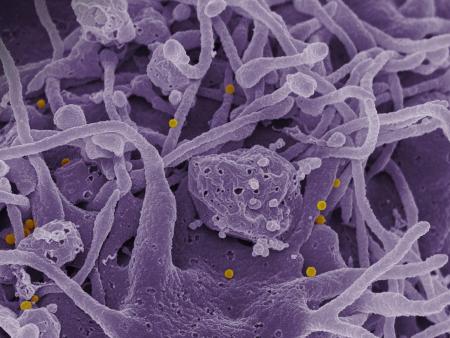NIH scientists develop macaque model to study Crimean-Congo hemorrhagic fever
Crimean-Congo hemorrhagic fever (CCHF) is a viral disease spread by ticks in the Middle East, Asia, Africa and parts of Europe. Infection with CCHF virus is fatal in nearly one of every three cases. No specific treatments or vaccines for CCHF exist, primarily because a suitable animal model for studying the disease has not been available. Scientists have used mice to study CCHF but had to weaken their immune systems to cause infection. Studies in larger animals have not consistently replicated human disease.

Scanning electron micrograph of CCHF viral particles (yellow) budding from the surface of cultured epithelial cells from a patient.
Now, as reported in Nature Microbiology, researchers have developed a new animal model to study the disease. Scientists at the National Institute of Allergy and Infectious Diseases, part of the National Institutes of Health, conducted a pilot study using CCHF virus to infect African green monkeys, rhesus macaques, and cynomolgus macaques. The strain of the virus they used, known as Kosova Hoti, was isolated from the blood of a person who died of CCHF. Most prior animal modeling studies had used a different viral strain isolated from a tick found in Nigeria.
The first two monkey species showed no signs of disease using various inoculation methods. Two of three cynomolgus macaques, however, developed disease. That led to a larger study of 12 cynomolgus macaques, four each inoculated under the skin, intravenously, or a combination of both. Within three days, all eight animals in the combination and intravenous groups showed signs of infection that led to severe disease. Two of the four animals inoculated under the skin developed mild signs of disease while the other two remained symptom-free.
Disease progression in the cynomolgus macaques followed the four phases that most infected people experience: 1) A 3- to 4-day incubation period; 2) a 3- to 5-day pre-hemorrhagic period; 3) a 2-to 3-day hemorrhagic period; and 4) recovery or death. Because their study included cynomolgus macaques that experienced a range of conditions, from no CCHF symptoms to severe disease, the scientists believe this animal model will be useful for examining how the infection progresses and interacts with the immune system. Ultimately, they plan to use the model to develop treatments and vaccines for CCHF.
Source: U.S. National Institutes of Health
- 359 reads
Human Rights
Ringing FOWPAL’s Peace Bell for the World:Nobel Peace Prize Laureates’ Visions and Actions

Protecting the World’s Cultural Diversity for a Sustainable Future

The Peace Bell Resonates at the 27th Eurasian Economic Summit

Declaration of World Day of the Power of Hope Endorsed by People in 158 Nations

Puppet Show I International Friendship Day 2020

